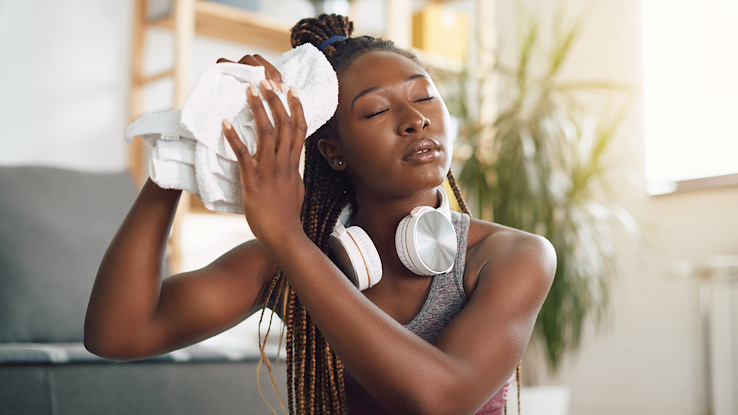What Is Jock Itch?: Causes, Symptoms, Treatments, and Prevention

Jock itch” is a common problem that is uncomfortable and may be embarrassing. The good news is that it’s not serious, it’s usually easily treated, and there are steps you can take, so it does not reoccur.
What is Jock Itch?
Also known as tinea cruris, “jock itch” is a fungal infection. It typically affects the genitals, inner thigh, and buttock areas. It gets its name as it is a common problem among athletes. The fungus, which can also cause athlete’s foot and ringworm, thrives in warm, moist environments.
Signs & Symptoms of Jock Itch
The typical signs and symptoms of jock itch include itchiness, redness, and a rash. Redness often begins in the skin creases of the groin. The rash usually takes on a half-moon or ring shape and can spread to the upper thighs and buttocks. The skin can become flaky and scaly, and in some cases, blisters can appear. Sometimes, the rash becomes painful or causes a fever to develop.
Jock itch symptoms are annoying and can be embarrassing. If you notice these signs and symptoms, you should consider starting treatment for the infection right away.
Causes of Jock Itch
Various types of fungus can cause jock itch. The fungus must be present in the environment for a person to pick it up and develop jock itch. Environments that are warm and damp, such as shower facilities and gymnasium locker rooms, are ideal places for the fungus to thrive.
Is jock itch contagious? Absolutely. It is often spread from person to person either by physical contact or contact with the fungus within the environment. Poor hygiene in damp, warm environments can facilitate the spreading of jock itch from person to person.
Contaminated towels can be the source of the spread. Because the same fungi that can cause athlete’s foot can also cause jock itch, it can be spread from the feet to the genitals and vice-versa when toweling off. You can also get jock itch from skin-to-skin contact with someone who has the fungus.
Risk Factors
Jock itch is typically associated with males of all ages. However, it is more common in teens, young people, and those who are regularly physically active. However, jock itch can occur in anyone! The rash usually develops in the creases, thighs, and buttocks in women and girls and may not affect the genitals.
Risk factors include:
- Wearing tight underwear
- Heavy sweating
- Being overweight
- Being immunocompromised
- Diabetes
If you spend a lot of time playing sports and using public shower facilities, it’s very important to take preventative steps to reduce your chances of developing jock itch.
How to Prevent Jock Itch

Athlete using a clean towel to prevent jock itch.
It’s not always possible to avoid contact with the fungus that causes jock itch. However, you can take steps to reduce your chances of developing a rash or spreading it to others.
- Keep dry. Dry your genital area thoroughly after showering, avoiding cross-contamination of the athlete’s foot to the genitals by drying the feet last. Using a topical antifungal powder may help prevent jock itch. You can also use an antiperspirant to reduce sweat build-up.
- Use clean towels and wear clean clothes. Change your underwear often and wear cotton underwear whenever possible.
- Wear loose-fitting clothes. Breathable fabrics and fits will help reduce the fungus’s ability to thrive.
- Watch out during warmer weather. Jock itch is more common in hot, humid weather so pay extra attention to your hygiene routine during these months.
- Treat athlete’s foot immediately. This can help you prevent spreading the fungus to your groin or passing it to others.
- Use shower shoes in public locker rooms. This will help prevent you from picking up the fungus that causes athlete’s foot and jock itch from shower floors.
- Don’t share equipment or towels. Since jock itch can be transferred via towels, clothing, and protective equipment, it’s important to use only your own items and avoid sharing your athletic and hygiene equipment with others. Keep all your equipment clean and dry.
- Ask your doctor about heavy sweating. If you sweat excessively, your doctor might be able to prescribe a prescription antiperspirant.
By preventing jock itch, you’re also helping to protect your teammates or other people who share public facilities with you. Taking a few extra hygiene steps can go a long way toward reducing both jock itch and athlete’s foot.
Diagnosis
Jock itch is easy to identify. If you need to visit your doctor, they will usually ask you some questions about your symptoms and examine any rash. You might not need to see your doctor for a diagnosis before starting treatment, as you can start treatment at home.
Treatments for Jock Itch
The treatment for jock itch is usually very simple. There are inexpensive over-the-counter fungal treatments to clear the rash. These treatments are often available at the drugstore in the form of sprays, powders, and creams. Make sure to apply them to clean, dry skin. You should also wash your hands thoroughly after touching the rash. Don’t scratch your rash, even if it itches.
Use these products for as long as recommended. If you stop treatment too early, the fungal infection may return.
More severe cases of jock itch might not clear up with over-the-counter products alone. If your symptoms have not resolved after two weeks, see your doctor. You may need a prescription medication to clear the infection.
Next Steps
Jock itch isn’t easy to talk about. Most people find it uncomfortable and embarrassing due to the location of the rash and the source of transmission. Fortunately, it’s a common problem with a very simple treatment process. It’s also unlikely to cause any significant health problems.
If you think you have jock itch, your next step should be consulting with your doctor or beginning treatment with over-the-counter products. Your doctor might recommend a cool compress to reduce symptoms like itching during the treatment process.
Once you have resolved the symptoms and eliminated the fungus causing the infection, you aren’t more likely to get jock itch again. Just be sure to take preventative measures to avoid picking up any fungal infections where they’re most likely to occur.
Resource Links:
- “Fungal Skin Infections” via National Institute for Clinical Excellence (NICE)
- “Ringworm and other fungal infections” via NHS Inform
- “Fungal Diseases” via Centers for Disease Control and Prevention (CDC)
- “About Ringworm” via Centers for Disease Control and Prevention (CDC)
- “Jock Itch” via MedlinePlus
- “Jock Itch” via the Mayo Clinic
- “The Best Way to Treat and Prevent Jock Itch” via Piedmont
- “Jock Itch: Care Instructions” via Myhealth Alberta
- “Jock Itch” via KidsHealth





